![]()
![]()
![]()
Use LEFT and RIGHT arrow keys to navigate between flashcards;
Use UP and DOWN arrow keys to flip the card;
H to show hint;
A reads text to speech;
34 Cards in this Set
- Front
- Back
|
12 Olympian Gods |
In the ancient Greek religion and Greek mythology, the Twelve Olympians are the major deities of the Greek pantheon, commonly considered to be Zeus, Hera, Poseidon, Demeter, Athena, Apollo, Artemis, Ares, Aphrodite, Hephaestus, Hermes and either Hestia, or Dionysus. |
|
|
Geometric |
Geometry (from the Ancient Greek: γεωμετρία; geo- "earth", -metron "measurement") is a branch of mathematics concerned with questions of shape, size, relative position of figures, and the properties of space. A mathematician who works in the field of geometry is called a geometer. |
|
|
Three classical orders of architecture |

The Architectural Orders are the ancient styles of classical architecture, each distinguished by its proportions and characteristic profiles and details, and most readily recognizable by the type of column employed. Three ancient orders of architecture—the Doric, Ionic, and Corinthian—originated in Greece |
|
|
Pronaos |
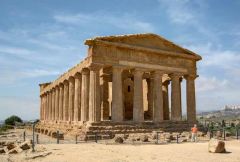
Roman temples commonly had an open pronaos, usually with only columns and no walls, and the pronaos could be as long as the cella. The word pronaos (πρόναος) is Greek for "before a temple". In Latin, a pronaos is also referred to as an anticum or prodomus. |
|
|
Cella |

A cella (from Latin for small chamber) or naos (from the Greek ναός, "temple") is the inner chamber of a temple in classical architecture, or a shop facing the street in domestic Roman architecture, such as a domus. |
|
|
peristyle |
a colonnade surrounding a building or an open space. 2. an open space, as a courtyard, surrounded by a colonnade. Origin of peristyle Expand. Latin. |
|
|
Stylobate |
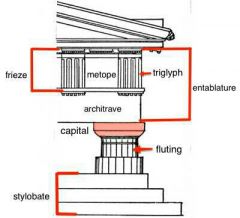
In classical Greek architecture, a stylobate (Greek: στυλοβάτης) is the top step of the crepidoma, the stepped platform upon which colonnades of temple columns are placed (it is the floor of the temple). The platform was built on a leveling course that flattened out the ground immediately beneath the temple. |
|
|
Kouros |
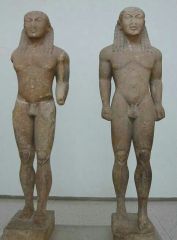
A kouros (Ancient Greek: κοῦρος, plural kouroi) is the modern term given to free-standing ancient Greek sculptures which first appear in the Archaic period in Greece and represent nude male youths. In Ancient Greek kouros means "youth, boy, especially of noble rank." |
|
|
Archaic smile |
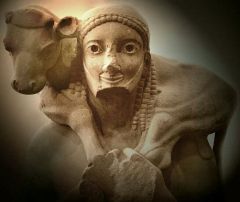
The Archaic smile was used by Greek Archaic sculptors, especially in the second quarter of the 6th century BCE, possibly to suggest that their subject was alive, and infused with a sense of well-being |
|
|
Kore |

Kore (Greek: κόρη "maiden"; plural korai) is the name given to a type of free-standing ancient Greek sculpture of the Archaic period depicting female figures, always of a young age. |
|
|
Peplos |
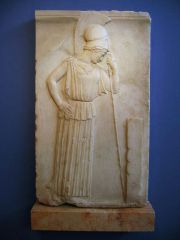
A peplos (Greek: ὁ πέπλος) is a body-length garment established as typical attire for women in ancient Greece by 500 BC (the Classical period). |
|
|
Amphora |

amphoras. 1 : an ancient Greek jar or vase with a large oval body, narrow cylindrical neck, and two handles that rise almost to the level of the mouth; broadly : such a jar or vase used elsewhere in the ancient world. 2 : a 2-handled vessel shaped like an amphora. |
|
|
Exekias |

Exekias (Ancient Greek: Ἐξηκίας, Exēkías) was an ancient Greek vase-painter and potter who was active in Athens between roughly 545 BC and 530 BC.Exekias - Wikipedia, the free encyclopedia |
|
|
Euphronios |
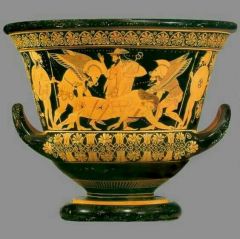
The Euphronios Krater (or Sarpedon krater) is an ancient Greek terra cotta calyx-krater, a bowl used for mixing wine with water. |
|
|
Black-figure |
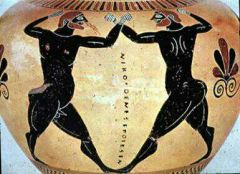
Black-figure pottery painting, also known as the black-figure style or black-figure ceramic (Greek, μελανόμορφα, melanomorpha) is one of the styles of painting on antique Greek vases. It was especially common between the 7th and 5th centuries BC, although there are specimens dating as late as the 2nd century BC. |
|
|
Red-figure |
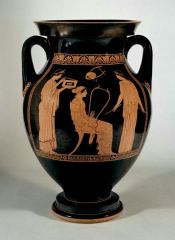
Red-figure vase painting is one of the most important styles of figural Greek vase painting. It developed in Athens around 520 BC and remained in use until the late 3rd century BC. It replaced the previously dominant style of black-figure vase painting within a few decades. |
|
|
symposium |

In ancient Greece, the symposium (Greek: συμπόσιον symposion, from συμπίνειν sympinein, "to drink together") was a drinking party. |
|
|
Kritios Boy |

The marble Kritios Boy or Kritian Boy belongs to the Early Classical period of ancient Greek sculpture. |
|
|
Contrapposto |
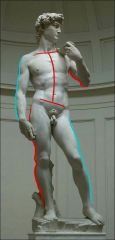
Contrapposto [kontrapˈposto] is an Italian term that means counterpose. It is used in the visual arts to describe a human figure standing with most of its weight on one foot so that its shoulders and arms twist off-axis from the hips and legs. |
|
|
The Riace warrior |
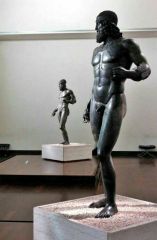
The Riace bronzes (Italian Bronzi di Riace [ˈbrondzi di riˈaːtʃe]), also called the Riace Warriors, are two full-size Greek bronzes of naked bearded warriors, cast about 460–450 BC that were found in the sea near Riace in 1972. |
|
|
golden age |
golden age. noun. A period of great peace, prosperity, and happiness. Greek & Roman Mythology The first age of the world, an untroubled and prosperous era during which people lived in ideal happiness. |
|
|
Acropolis |
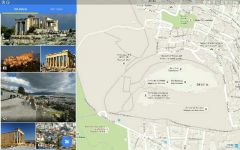
The Acropolis of Athens is an ancient citadel located on a extremely rocky outcrop above the city of Athens and contains the remains of several ancient buildings of great architectural and historic significance, the most famous being the Parthenon. |
|
|
Parthenon |
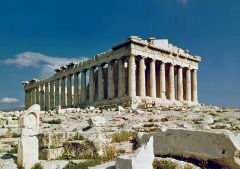
The Parthenon is a former temple on the Athenian Acropolis, Greece, dedicated to the goddess Athena, whom the people of Athens considered their patron. Construction began in 447 BC when the Athenian Empire was at the peak of its power. |
|
|
Phidias |
Phidias or Pheidias (/ˈfɪdiəs/; Greek: Φειδίας, Pheidias; c. 480 – 430 BC) was a Greek sculptor, painter and architect. His statue of Zeus at Olympia was one of the Seven Wonders of the Ancient World. |
|
|
Panathenaic Festival |
noun. 1. a festival in honor of the goddess Athena, celebrated yearly in ancient Athens, with each fourth year reserved for greater pomp, marked by contests, as in athletics and music, and highlighted by a solemn procession to the Acropolis bearing a peplos embroidered for the goddess. Expand. Also, Panathenaia. |
|
|
Polykleitos |
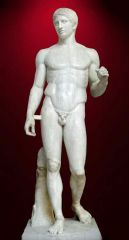
Polykleitos was an ancient Greek sculptor in bronze of the 5th century BCE. His Greek name was traditionally Latinized Polycletus, but is also transliterated Polycleitus; (Ancient Greek: Πολύκλειτος, "much-renowned") and due to iotacism in the transition from Ancient to Modern Greek, Polyklitos or Polyclitus. |
|
|
Spear-Bearer (Doryphoros) |
The Doryphoros (Greek Δορυφόρος, "Spear-Bearer"; Latinised as Doryphorus) of Polykleitos is one of the best known Greek sculptures of the Classical Era in Western Art, depicting a solidly-built, well-muscled standing athlete, originally bearing a spear balanced on his left shoulder. Rendered somewhat above life-size proportions, the lost bronze original of the work would have been cast circa 440 BCE,[1] but it is today known only from later (mainly Roman period) marble copies. The work nonetheless forms an important early example of both Classical Greek contrapposto and Classical realism; as such, the iconic Doryphoros proved highly influential elsewhere in ancient art. |
|
|
Canon |
A biblical canon or canon of scripture is a list of texts (or "books") which a particular religious community regards as authoritative scripture. The word "canon" comes from the Greek κανών, meaning "rule" or "measuring stick". |
|
|
Lord Elgin |
The Elgin Marbles, also known as the Parthenon Marbles, are a collection of Classical Greek marble sculptures (made by the citizens of Athens under the supervision of the renowned architect and sculptor Phidias and his assistants), inscriptions, and architectural pieces that were originally part of the temple of the Parthenon and other buildings on the Acropolis of Athens.[1][2] Thomas Bruce, 7th Earl of Elgin obtained in 1801 a controversial permit[3] from the Sublime Porte, which then ruled Greece.From 1801 to 1812, Elgin's agents removed about half of the surviving sculptures of the Parthenon, as well as sculptures from the Propylaea and Erechtheum.[4] The Marbles were transported by sea to Britain. In Britain, the acquisition of the collection was supported by some,[5] while others, such as Lord Byron, likened Elgin's actions to vandalism[6] or looting.[7][8][9][10][11]Following a public debate in Parliament[12] and the subsequent exoneration of Elgin, the marbles were purchased from Elgin by the British government in 1816 and were passed to the British Museum,[13] where they are on display in the purpose-built Duveen Gallery. |
|
|
Nike |
Nike (/ˈnaɪki/; Greek: Νίκη, "Victory", Ancient Greek: [nǐːkɛː]), in ancient Greek religion, was a goddess who personified victory, also known as the Winged Goddess of Victory. The Roman equivalent was Victoria. |
|
|
Stele |
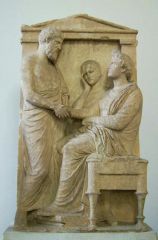
A stele (plural steles or stelai, from Greek: στήλη, stēlē) or stela (plural stelas or stelæ, from Latin) is a stone or wooden slab, generally taller than it is wide, erected as a monument, very often for funerary or commemorative purposes. |
|
|
Praxiteles |
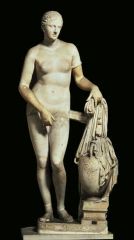
Praxiteles (/prækˈsɪtᵻliːz/; Greek: Πραξιτέλης, etymology: he who finishes his works) of Athens, the son of Cephisodotus the Elder, was the most renowned of the Attic sculptors of the 4th century BC. He was the first to sculpt the nude female form in a life-size statue.Praxiteles - Wik |
|
|
Hellenistic |
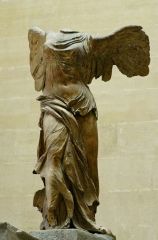
The Hellenistic period covers the period of ancient Greek (Hellenic) history and Mediterranean history between the death of Alexander the Great in 323 BC and the emergence of the Roman Empire as signified by the Battle of Actium in 31 BC and the subsequent conquest of Ptolemaic Egypt the following year. |
|
|
Laocoön |
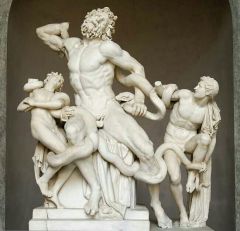
Laocoön (/leɪˈɒkoʊˌɒn, -kəˌwɒn/; Ancient Greek: Λαοκόων, IPA: [laokóɔːn]), the son of Acoetes, is a figure in Greek and Roman mythology and the Epic Cycle. He was a Trojan priest who was attacked, with his two sons, by giant serpents sent by the gods. |

